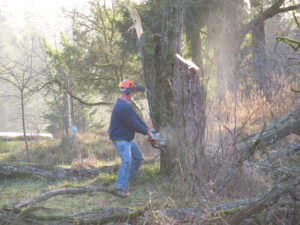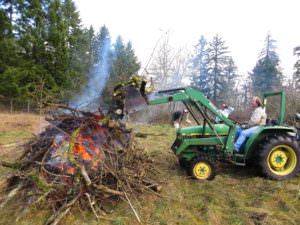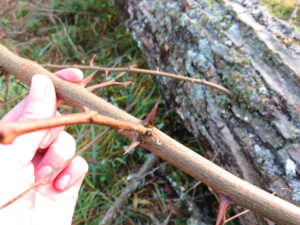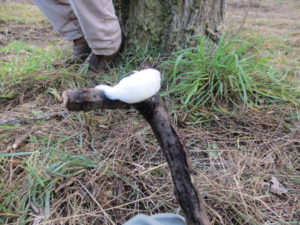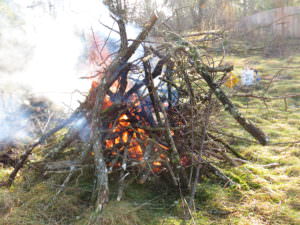Protecting native prairies by removing invasive trees
People who have visited Wolf Haven before might have noticed some large trees in a small grassy area, just west of the parking lot, near three bat boxes. Those trees were Black Locust Trees, also known as False Acacia, or by its scientific name Robinia pseudoacacia. Black Locust trees are native to the Southeastern United States, but have been transplanted by people to other parts of the world, and have become invasive in many areas, including the Pacific Northwest. The Black Locust trees on Wolf Haven’s property were likely planted by the family of a homesteader who owned the area previously. As part of our mission to restore and protect native prairies, the Center For Natural Lands Management (CNLM) had a volunteer day at Wolf Haven to get rid of the invasive Black Locust Trees.
We started in the morning by cutting the trees down with chainsaws, then we cut the trees up into manageable sizes. Meanwhile, a fire was being started with kindling and smaller branches. As the fire grew, we were able to put larger and larger pieces of black locust onto the burn piles, or bonfires as they can be called. Some of the logs were so large that we needed Wolf Haven’s Grounds/Facilities Manager, Tim McElwee, to help us on the tractor.
Like true Acacias, False Acacias have thorns, which we had to be careful with
when cutting and holding the branches. These thorns are up to 2 centimeters long, and grow in pairs along most of the smaller branches. In addition to these thorns, Black Locusts have a toxin that can make livestock who eat parts of the plant sick, as well acting as a fish toxin. Through the day, we noticed a foul-smelling white foam boiling out of the ends of branches and logs. This foam was probably the toxin oozing out of the plant and becoming inactive by the heat.
By the end of the day, we had two huge burn piles, which were too hot to get within a few feet of, burning white hot. CNLM and Wolf Haven hope that with the removal of these invasive trees, the small oaks and apple trees in the same area will get more sun, the bat boxes will get more use (since bats prefer to use boxes in open areas), and the area will be turned into a demo-prairie to grab visitor’s attention as they enter Wolf Haven.
Anne Schuster
Center for Natural Lands Management AmeriCorps, Wolf Haven Outreach and Restoration Technician

